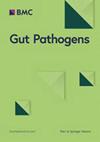国内外流行的猪流行性腹泻病毒毒株的遗传进化和系统发育分析,以中国广东省报告的野生型毒力基因型 CHYJ130330 为参照
IF 4.3
3区 医学
Q1 GASTROENTEROLOGY & HEPATOLOGY
引用次数: 0
摘要
在过去十年中,猪流行性腹泻病毒对养猪业造成了不利影响,尤其是在哺乳仔猪中爆发严重疫情。2013 年 3 月,中国南方广东省的一个商品猪场爆发了猪流行性腹泻病毒疫情。经鉴定,发现了一株名为 CHYJ130330 的野生型 PEDV 株系,对其进行了全基因组测序,并将其存入 GenBank(登录号:KJ020932)。本研究探讨了分子流行病学,包括进化特征和致病性评估,特别关注并重点开发用于新疫苗的候选毒株。2013 年前后从中国分离的菌株与野生型 CHYJ130330 株系的 nt 一致度分别为 96.5-97.2% 和 97-99%,而野生型 CHYJ130330 株系在实验研究中表现出很高的致病力,104 TCID50 组仔猪在 5 天内死亡率达 100%。除中国(CV777)和韩国(vir.DR13、SM98 和 atten.DR13)菌株与我们的序列的同一性分别为 96.8%、97.6%、96.6% 和 97.1%外,从世界其他地区选取的 22 个参考菌株与我们的序列的同一性均为 98-99%。系统发生树显示,2013年后报道的大多数毒株属于GII基因组,而原型(CV777)、韩国和早期中国毒株(JS2008、85-7突变株、Aten.疫苗、SD-M、LZC和CH/S)属于GI基因组。与 CV777 株相比,CHYJ130330 的 E 蛋白和 M 蛋白的氨基酸序列高度保守,而 ORF3 和 N 蛋白分别有 9 和 17 个氨基酸的替换。比较全长基因组和结构蛋白发现的变异表明,尽管持续接种疫苗,PEDV 变异株仍是疫情暴发的主要来源,也解释了与 2010 年前发现的零星发病趋势相比,这十年间大规模疫情暴发的不同趋势。本研究表明,中国毒株与其他国家报告的毒株有明显的混合。此外,CHYJ130330 株系还成功适应了 Vero 细胞系,并在仔猪中显示出较高的毒力。这些信息/发现将有助于制定PEDV的控制策略,同时也表明CHYJ130330毒株具有很强的毒力,是近年来较流行的临床毒株,有潜力开发成PEDV疫苗。本文章由计算机程序翻译,如有差异,请以英文原文为准。
Genetic evolution and phylogenetic analysis of porcine epidemic diarrhea virus strains circulating in and outside China with reference to a wild type virulent genotype CHYJ130330 reported from Guangdong Province, China
During the last decade, porcine epidemic diarrhea virus has detrimental consequences on swine industry, due to severe outbreaks especially in the suckling piglets. In March 2013, an outbreak was reported on a commercial swine farm in Guangdong Province, Southern China. A wild-type PEDV strain named as CHYJ130330 was identified, complete genome was sequenced and deposited in GenBank (accession no. KJ020932). The molecular epidemiological including evolutionary characteristics and pathogenicity assessment were explored during this study with particular interest and focus to develop this candidate strain for new vaccine. The isolates from China pre- and post-2013 shared 96.5–97.2% and 97–99% nt identity respectively with wild-type CHYJ130330 strain which during experimental studies has demonstrated high virulence and 100% mortality in 104 TCID50 group piglets within 5 days. The 22 reference strains selected from other parts of the world shared 98–99% identity with our sequence except Chinese (CV777) and S. Korean (vir.DR13, SM98 and atten.DR13) strains sharing 96.8, 97.6, 96.6 and 97.1% identity respectively. The phylogenetic tree revealed most strains reported after 2013 in GII genogroup while the prototype (CV777), S.korean and earlier Chinese (JS2008, 85-7mutant, Atten.vaccine, SD-M, LZC and CH/S) were GI Group. The amino acid sequence of CHYJ130330 E and M protein is highly conserved while ORF3 and N protein having 9 and 17 amino acid substitutions respectively in comparison to CV777 strain. The comparison of full length genome and the structural proteins revealed variations signifying that PEDV variant strains are still the main source of outbreaks in spite of continuous vaccination and also explain the variable trend of large scale outbreaks during this decade as compared to sporadic tendency of disease found before 2010. It is evident from this study that Chinese strains display significant level of mixing with the strains reported from other countries. The strain CHYJ130330 was also adapted successfully to Vero cell line and has shown high virulence in piglets. The information/findings will be helpful to develop a strategy for control of PEDV and have also shown that CHYJ130330 strain has strong virulence and is a more popular clinical strain in recent years, which has the potential to be developed into PEDV vaccine.
求助全文
通过发布文献求助,成功后即可免费获取论文全文。
去求助
来源期刊

Gut Pathogens
GASTROENTEROLOGY & HEPATOLOGY-MICROBIOLOGY
CiteScore
7.70
自引率
2.40%
发文量
43
期刊介绍:
Gut Pathogens is a fast publishing, inclusive and prominent international journal which recognizes the need for a publishing platform uniquely tailored to reflect the full breadth of research in the biology and medicine of pathogens, commensals and functional microbiota of the gut. The journal publishes basic, clinical and cutting-edge research on all aspects of the above mentioned organisms including probiotic bacteria and yeasts and their products. The scope also covers the related ecology, molecular genetics, physiology and epidemiology of these microbes. The journal actively invites timely reports on the novel aspects of genomics, metagenomics, microbiota profiling and systems biology.
Gut Pathogens will also consider, at the discretion of the editors, descriptive studies identifying a new genome sequence of a gut microbe or a series of related microbes (such as those obtained from new hosts, niches, settings, outbreaks and epidemics) and those obtained from single or multiple hosts at one or different time points (chronological evolution).
 求助内容:
求助内容: 应助结果提醒方式:
应助结果提醒方式:


